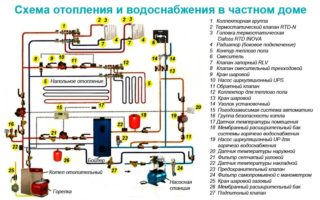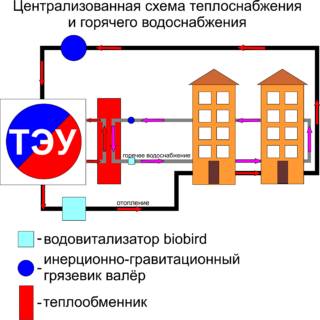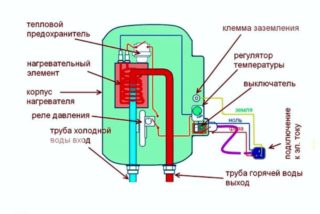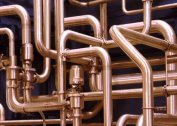Uninterrupted supply of residents of settlements and enterprises with water heated to 75 degrees is an indicator of high quality of life. In order not to reduce it, it is important to choose the right heat supply system, including hot water supply in a private house or apartment.
Hot water supply
 The flow of hot water to an apartment building or a country house depends on whether the water supply system is used: open or closed. In the first case, the liquid flows directly from the central heating main. More often this option is found in high-rise buildings. The supply of warm water can be done through natural circulation or using pumps.
The flow of hot water to an apartment building or a country house depends on whether the water supply system is used: open or closed. In the first case, the liquid flows directly from the central heating main. More often this option is found in high-rise buildings. The supply of warm water can be done through natural circulation or using pumps.
The action of gravity hot water takes place on the principle of displacing a hot stream with cold water, which has more density and mass. The benefits are in energy independence at the time of fluid transfer. Energy consumption is only when heating boilers. The disadvantage is the need for accurate calculation of the slope of the pipeline and the use of elements with a large cross section.
If gravity is not available, installation of pumping equipment will be required.
Advantages of open systems:
- No need to control the pressure, the air descends automatically.
- It is easier to add water through the expansion tank.
- Less risk of leaks.
The downside is the mandatory control of the water in the tank and the need to replenish it.
The difference between the closed type of hot water supply is in the intake of cold liquid from the water supply and its heating in an additional device. After the hot stream is redistributed to the points of water intake. This allows you to maintain the desired temperature in all areas of the water supply. But this option will require additional wiring and installation of heating equipment.
Closed supply systems can be dead ends or operate on a recirculation scheme. In the latter case, hot water flows through a closed ring of the pipeline, and heating is carried out not only due to the storage heat exchanger, but also using an indirect source. The dead end hot water distribution system is made up of only supply branches coming from the heating element.
Types of DHW connection systems, operating principle and standards
 According to the method of connecting the DHW system are divided into centralized and autonomous. The first type involves heating the liquid in thermal substations and delivering it to the consumer through a specialized open or closed line.
According to the method of connecting the DHW system are divided into centralized and autonomous. The first type involves heating the liquid in thermal substations and delivering it to the consumer through a specialized open or closed line.
When supplying central hot water, certain norms and requirements must be observed. According to SanPiNam and SNIP:
- The temperature of the aquatic environment should be above 40 degrees. Deviation up to five degrees is allowed.
- The period of shutdown of hot water due to an accident should not be more than eight hours per month.
- The maximum time for maintenance work in the summer is two weeks.
To control the flow of hot water, the meters are installed. These devices have the right to install only specialists of the managing organization engaged in the supply of hot water under an agreement with the owner of the apartment or house.
In autonomous systems, heating is carried out due to heating appliances - boilers, gas water heaters, various boilers. It is usually used in private homes, but recently, due to interruptions in the supply of hot water or non-compliance with standards, tenants of apartments in high-rise buildings began to install them.
Typical DHW schemes
There are three types of hot water supply schemes:
- Cumulative. Usually used in country houses with a simple (dead-end) network for distributing water flows. Boilers are installed as storage tanks.
- Flowing. They are used in cases where a constant analysis of hot water is required. Heating is carried out using plate or tubular heat exchangers.
- Combined. Both flowing and storage water heaters are installed in the room.
The most economical hot water circuit with circulation. In this case, the flow circulates through the network due to pumping equipment, which takes water from the return pipe and transfers it to the heater. It is used in residential cottages, hospitals, kindergartens, hotels - where a constant flow of warm liquid into the taps is required.
The choice of an autonomous hot water system and operation features
 To organize hot water supply in a residential private house, where there is no connection to the central network, additional heating equipment will be required.
To organize hot water supply in a residential private house, where there is no connection to the central network, additional heating equipment will be required.
Accumulative boilers
Tanks where the water heats up and stays warm for a long time in a thermos. The choice of such a device depends on its volume:
- Up to 10 liters is enough for washing dishes and wet cleaning.
- Up to 100 liters - enough for a shower for a family of three, cleaning and washing dishes.
- Over 100 liters - can be installed in the house where a large family lives.
Such systems create a reserve of hot water, which is important during interruptions with its supplies and outages. The tank can be installed anywhere - in the bathroom or in the kitchen. But heating takes time and energy.
Modern designs of storage devices are equipped with additional functions. These include the ability to work both in economy mode and at maximum, as well as delaying the start of heating. The housings are thermally insulated so that the hot water is stored for a long time and the energy used is saved.
Instantaneous heaters
Suitable for all types of houses, because they work on the principle of heating the supplied cold water. They do not take up much space; they can be of the upper or lower type (attached to the wall or mounted on the floor). Hot water flows directly to the taps.
Heaters also have disadvantages. It will be necessary to drain the cooled water from the previous start. When using several sections of the catchment, there is not enough heating for everything, the water will be slightly warm. To prevent this, calculate the power of the device. For one kitchen faucet, 10 kW is needed, but if a bath is typed, the power should be at least 28 kW.
Energy sources for heating water also vary. It can be a gas or electric double-circuit system or an indirect heating source. The latter type is beneficial in the winter, as it draws warm water from a home heating system. The use of the second circuit allows us to solve the problem of the supply of hot water and heating the building.
Recently, alternative energy sources have been in demand. Solar panels and windmills are not yet so popular, but pellet and peat briquette boilers are increasingly used. Their advantage is cheaper fuel. For equipment, an external arrangement is possible: not in the house itself, but in the utility room.
The organization of hot water supply in a private house or apartment is limited only by the financial capabilities of the owners. Options for heating devices, piping elements and methods for generating energy are diverse. Regardless of the choice, the circuit should be compliant, functional and safe.



